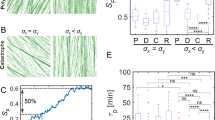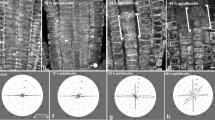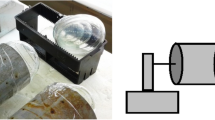Abstract.
The organization of cortical microtubules at wound sites in Nitella pseudoflabellata(A. Br. & Nordst.) em. R.D.W. and N. flexilis(L.) Ag. internodal cells was examined in relation to the regeneration of actin filament bundles in order to identify the mechanisms by which microtubules are oriented. Actin bundle regrowth occurs prior to that of microtubules, so it was considered possible that microtubule alignment is actin-dependent, perhaps mediated by cross-linking proteins. In all types of wounds investigated, subcortical actin bundles regenerated parallel to the direction of cytoplasmic streaming. Microtubule orientation patterns, however, varied according to the nature of wound formation and the type of wound wall eventually produced. In chloroplast-free windows induced by blue light irradiation, microtubule orientation varied according to the size of the window. Microtubules were randomized in 10- to 30-μm-wide windows where exposure to cytoplasmic flow is minimal, but were aligned more or less parallel to regenerated actin bundles in 80- to 100-μm-wide windows. Where co-alignment between microtubules and actin bundles was obvious after fluorescence labelling, electron micrographs revealed that microtubules and actin bundles were too widely spaced to account for any cross-linkages. Furthermore, treatments that inhibited or reduced cytoplasmic streaming without altering the direction of actin bundles caused randomization of microtubules previously oriented in the streaming direction, even in the presence of taxol. When evenly flat wound walls were induced by 10−4 M chlortetracycline, microtubules were co-aligned with nearby actin bundles at the surface of the wound wall. At wounds induced by treatment with 5 × 10−2 M CaCl2, however, microtubules were randomly oriented and preferentially located in the narrow clefts between the wound-wall protuberances, up to several micrometers away from the actin bundles near the wound-wall tips. These results indicate that microtubules regenerated in wounds are merely co-aligned with actin filament bundles because they are passively aligned by the hydrodynamic forces created by cytoplasmic flow.
Similar content being viewed by others
Author information
Authors and Affiliations
Additional information
Received: 4 August 1998 / Accepted: 30 January 1999
Rights and permissions
About this article
Cite this article
Foissner, I., Wasteneys, G. Microtubules at wound sites of Nitella internodal cells passively co-align with actin bundles when exposed to hydrodynamic forces generated by cytoplasmic streaming. Planta 208, 480–490 (1999). https://doi.org/10.1007/s004250050585
Issue Date:
DOI: https://doi.org/10.1007/s004250050585




